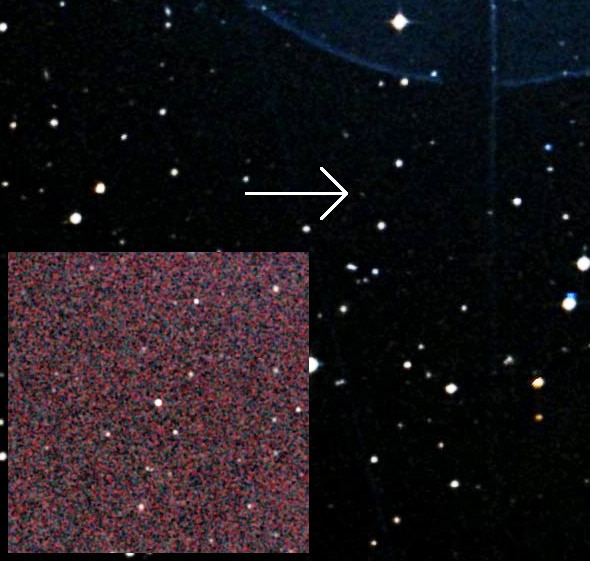Create a free profile to get unlimited access to exclusive videos, sweepstakes, and more!
The Smallest Star

Astronomers may have identified what may be the smallest known star. And not just the smallest known star but quite possibly the smallest possible star. If it were any smaller, it might not even be a star anymore.
The star in question is called 2MASS J05233822-1403022, but I’ll call it J0523 for short (the name comes from its discovery in the 2-Micron All Sky Survey (2MASS), together with its coordinates on the sky). As weaklings go, it’s just about the weakest: It shines only 1/8,000th as brightly as the Sun, has a temperature of 1,800° C (compared with the Sun’s 5,600°), and a diameter a mere 0.09 times the Sun’s—smaller than Jupiter!
It’s actually relatively close by at about 40 light years, but so faint you need a big telescope just to see it at all—the faintest star you can see with your naked eye is still a million times brighter than J0523!
So how do we know it’s (maybe) the smallest star?
Well, we have to define what we mean by “star.” Astronomers say a star is a gaseous object massive enough to fuse hydrogen into helium in its core. The Sun does this, so it’s a star. Jupiter doesn’t, so it isn’t.
It turns out that to get this fusion going, you need to squeeze hydrogen pretty hard. Planets don’t have the oomph needed for this, but if you pile on enough material, the pressure and temperature in the core rise, and you eventually get to the point where hydrogen fusion ignites.
We think that mass limit is around 0.07–0.077 times that of the Sun. If you have more than that, you fuse. Less, you lose.
But that range is bigger than we’d like. It would be nice to narrow it down some. So, to set some boundaries, a team of astronomers who study nearby stars decided to look for very low mass stars around the fusion limit, as well as objects clearly below that limit. We call those latter objects brown dwarfs.
There’s a funny thing about stars versus brown dwarfs. If you take a star and add mass to it, it gets hotter and bigger. That’s because the rate of fusion in the core is very sensitive to its mass. If you add a bit of mass, the fusion rate goes up, so the temperature increases, and the star expands a bit. (It's essentially made of gas, after all, and when you heat a gas it expands.)
Brown dwarfs are different, though. Their cores are squeezed pretty hard by all their mass, but not enough to initiate fusion. The matter there is in a weird quantum mechanical state called degeneracy, which has the decidedly odd property that if you add mass to a brown dwarf, it gets smaller.
So the astronomers did a very clever thing. They found 63 objects near the fusion mass limit and plotted their size versus their surface temperature (which itself depends on mass, but can be more easily and directly measured). As you go to lower masses, stars have lower temperatures and smaller radii, but once you jump over into the brown dwarf regime, a lower temperature (and therefore lower mass) gives you a larger radius.
The astronomers plotted the objects’ properties, and sure enough as temperature dropped so did the size, until it reached a minimum before starting to increase again. That minimum must be where the brown dwarf/normal star boundary is … and they found good ol’ J0523 sitting right there, just on the stellar side of it.
And that’s why we think J0523 is the smallest star. It’s also the least massive, and coolest. If it had any less mass, it wouldn’t be a star at all, but a brown dwarf.
Now mind you, it’s not like this limit is hard and fast. It’s affected by other factors, including a star’s age, the abundance of “metals” a star has in it (astronomers call all elements heavier than helium “metals,” which is a bit confusing for nonastronomers; but H and He are by far the most abundant elements in the Universe, while everything else is essentially contamination), and even how fast a star spins.
In fact, this observation is at odds with theoretical models, which predict a cooler temperature for the mass limit, closer to 1,400° Celsius. It’s unclear why there’s a discrepancy. It could be due to the factors I mentioned above, or it may be that the observations are suffering from some unknown bias (to be fair, 63 stars isn’t very many to look at statistically speaking, but these stars are so faint it’s difficult to get a big, unbiased sample; still, the team of astronomers is working on increasing the sample size). It’s also possible our understanding of the physics of brown dwarf cores is a bit off, too. Things are always difficult at the boundaries.
Given all that, it’s fair to say that an actual by-the-definition star with a lower mass than J0523 could be found. It’s entirely possible. But until then, J0523 holds the record for last place.
And either way, here’s something to ponder: As I mentioned above, the rate at which fusion occurs depends on the mass of the star. J0523 has the lowest possible mass for fusion, so it’s taking its sweet time using up its hydrogen fuel. Given that, it’s so miserly that it has a lifespan far, far longer than the Sun. It could literally still be fusing merrily (though feebly) away even a trillion years from now!
These tiny stars are hard to find, harder to study, and still confound our best scientists … and even if we do eventually figure them out, they’ll still have the last laugh. A long, long time in the future.


























